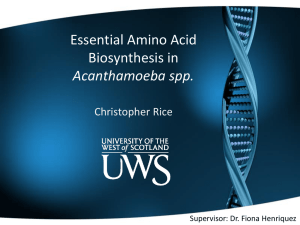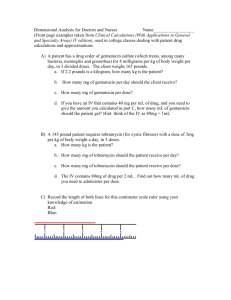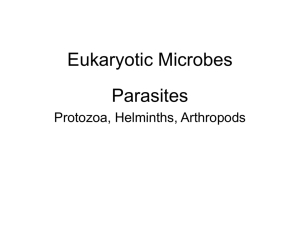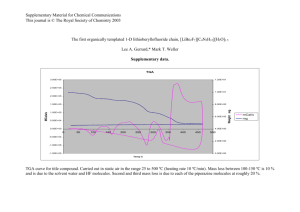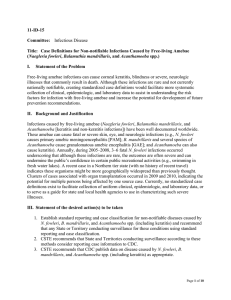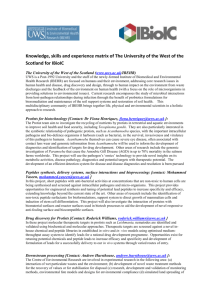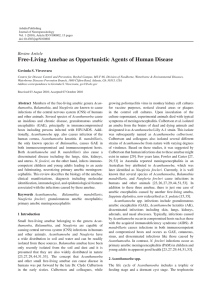1 - Virginia Tech English Department Faculty
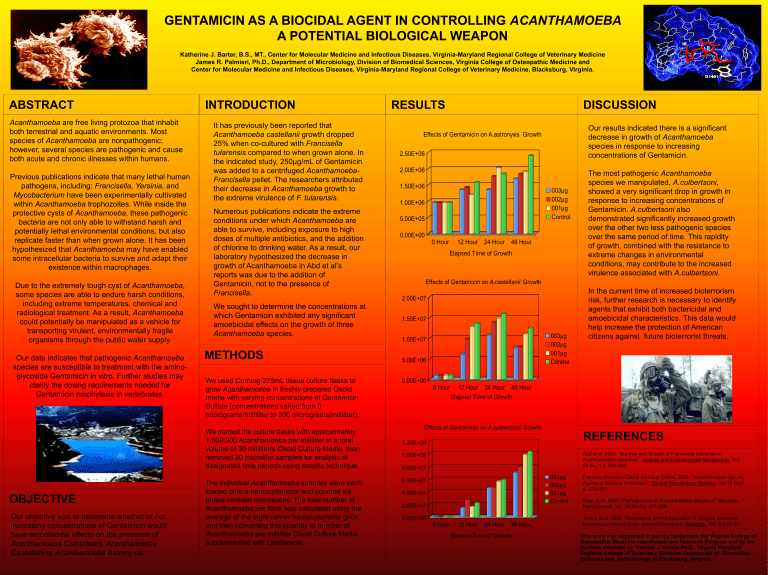
GENTAMICIN AS A BIOCIDAL AGENT IN CONTROLLING ACANTHAMOEBA
A POTENTIAL BIOLOGICAL WEAPON
Katherine J. Barter, B.S., MT., Center for Molecular Medicine and Infectious Diseases, Virginia-Maryland Regional College of Veterinary Medicine
James R. Palmieri, Ph.D., Department of Microbiology, Division of Biomedical Sciences, Virginia College of Osteopathic Medicine and
Center for Molecular Medicine and Infectious Diseases, Virginia-Maryland Regional College of Veterinary Medicine, Blacksburg, Virginia.
ABSTRACT
Acanthamoeba are free living protozoa that inhabit both terrestrial and aquatic environments. Most species of Acanthamoeba are nonpathogenic; however, several species are pathogenic and cause both acute and chronic illnesses within humans.
Previous publications indicate that many lethal human pathogens, including: Francisella, Yersinia, and
Mycobacterium have been experimentally cultivated within Acanthamoeba trophozoites. While inside the protective cysts of Acanthamoeba , these pathogenic bacteria are not only able to withstand harsh and potentially lethal environmental conditions, but also replicate faster than when grown alone. It has been hypothesized that Acanthamoeba may have enabled some intracellular bacteria to survive and adapt their existence within macrophages.
Due to the extremely tough cyst of Acanthamoeba , some species are able to endure harsh conditions, including extreme temperatures, chemical and radiological treatment. As a result, Acanthamoeba could potentially be manipulated as a vehicle for transporting virulent, environmentally fragile organisms through the public water supply.
Our data indicates that pathogenic Acanthamoeba species are susceptible to treatment with the aminoglycoside Gentamicin in vitro. Further studies may clarify the dosing requirements needed for
Gentamicin prophylaxis in vertebrates.
METHODS
OBJECTIVE
Our objective was to determine whether or not increasing concentrations of Gentamicin would have amoebicidal effects on the presence of
Acanthamoeba Culbertsoni, Acanthamoeba
Castellani or Acanthamoeba Astronyxis.
INTRODUCTION
It has previously been reported that
Acanthamoeba castellanii growth dropped
25% when co-cultured with Francisella tularensis compared to when grown alone. In the indicated study, 250µg/mL of Gentamicin was added to a centrifuged Acanthamoeba-
Francisella pellet. The researchers attributed their decrease in Acanthamoeba growth to the extreme virulence of F. tularensis .
Numerous publications indicate the extreme conditions under which Acanthamoeba are able to survive, including exposure to high doses of multiple antibiotics, and the addition of chlorine to drinking water. As a result, our laboratory hypothesized the decrease in growth of Acanthamoeba in Abd et al’s reports was due to the addition of
Gentamicin, not to the presence of
Francisella .
We sought to determine the concentrations at which Gentamicin exhibited any significant amoebicidal effects on the growth of three
Acanthamoeba species .
We used Corning 275mL tissue culture flasks to grow Acanthamoeba in freshly prepared Oxoid media with varying concentrations of Gentamicin
Sulfate (concentrations varied from 0 micrograms/milliliter to 300 micrograms/milliliter).
We started the culture flasks with approximately
1,000,000 Acanthamoeba per milliliter in a total volume of 30 milliliters Oxoid Culture Media, than removed 20 microliter samples for analysis at designated time periods using aseptic technique.
The individual Acanthamoeba samples were each loaded onto a hemacytometer and counted via phase contrast microscopy. The total number of
Acanthamoeba per flask was calculated using the average of the eight corner hemacytometer grids and then converting this quantity to number of
Acanthamoeba per milliliter Oxoid Culture Media supplemented with Gentamicin.
RESULTS
Effects of Gentamicin on A.astronyxis Growth
2.50E+06
2.00E+06
1.50E+06
1.00E+06
5.00E+05
0.00E+00
0 Hour 12 Hour 24 Hour 48 Hour
Elapsed Time of Growth
003μg
002μg
001μg
Control
2.00E+07
Effects of Gentamicin on
A.castellanii
Growth
1.50E+07
1.00E+07
5.00E+06
003μg
002μg
001μg
Control
DISCUSSION
Our results indicated there is a significant decrease in growth of Acanthamoeba species in response to increasing concentrations of Gentamicin.
The most pathogenic Acanthamoeba species we manipulated, A.culbertsoni
, showed a very significant drop in growth in response to increasing concentrations of
Gentamicin. A.culbertsoni
also demonstrated significantly increased growth over the other two less pathogenic species over the same period of time. This rapidity of growth, combined with the resistance to extreme changes in environmental conditions, may contribute to the increased virulence associated with A.culbertsoni
.
In the current time of increased bioterrorism risk, further research is necessary to identify agents that exhibit both bactericidal and amoebicidal characteristics. This data would help increase the protection of American citizens against future bioterrorist threats.
0.00E+00
0 Hour 12 Hour 24 Hour 48 Hour
Elapsed Time of Growth
Effects of Gentamicin on
A.culbertsoni
Growth
1.20E+08
1.00E+08
8.00E+07
6.00E+07
4.00E+07
2.00E+07
0.00E+00
0 Hour 12 Hour 24 Hour 48 Hour
Elapsed Time of Growth
003μg
002μg
001μg
Control
REFERENCES
Abd et al. 2003. “Survival and Growth of Francisella tularensis in
Acanthamoeba castellanii”. Applied and Environmental Microbiology. Vol.
69 No. 1 p. 600-606.
Francine MarcianoCabral and Guy Cabral. 2003. “ Acanthamoeba spp. as
Agents of Disease in Humans”. Clinical Microbiology Reviews. Vol.16 No.2, p. 273
–307.
Khan et al. 2003. “Pathogenesis of Acanthamoeba infections”. Microbial
Pathogenesis. Vol. 34 No.6 p. 277-285.
Tomov et al. 1999. “Persistence and Multiplication of Obligate Anaerobe
Bacteria in Amebae Under Aerobic Conditions” Anaerobe. Vol. 5 p.19-23.
This work was supported in part by funds from the Virginia College of
Osteopathic Medicine Interdisciplinary Research Program and by the facilities provided by Thomas J. Inzana Ph.D., Virginia Maryland
Regional College of Veterinary Medicine Department of Biomedical
Sciences and Pathobiology in Blacksburg, Virginia.

